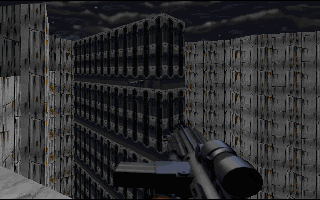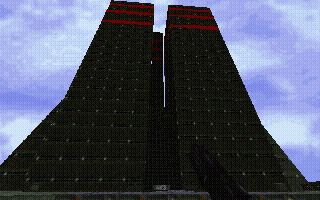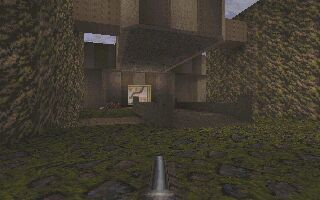Classic Games Emulation | News | Systems | Emulation | Emulators | Games | Links
PC Games

Dark Forces
1994, Lucas Arts
Dark Forces is a first-person shooter set in the Star Wars universe. The main character is Kyle Katarn, a former imperial soldier turned mercenary whom the rebellion hires to put an end to the Empire's plan to build extremely powerful robotic stormtroopers called dark troopers. (Yes, I know. A 3D shooter with a plot? Quite shocking.) It has 15 missions filled with bounty hunters, imperial troops and droids, and, yes, the dreaded dark troopers.
Dark Forces came during the wave of DOOM clones, but it stood well above most of the other first-person, 3D shooters of the time. First, it's a Star Wars game which always counts for something. But even ignoring that, it is still a great game. Each level has its own distinct atmosphere, and impressive level design, featuring large, open areas (many of them outdoors) and large vertical structures (several structures are at least six stories tall). Unlike the DOOM engine, the 3D engine in Dark Forces (the "Jedi Engine") allows for one vertical level to be placed over another. Additionally, it had a large variety of textures, and allowed for different palettes for each mission, all of which contributed to differentiating one mission from another. And the 3D engine supported atmospheric effects like fogging (which was exploited rather well in the Gromas Mine mission). It had its own scripting language for controlling elevators, moving walls, and so on, which gave level designers a lot of flexibility. And, again, it did have a fairly well detailed plot, which helped to distinguish it from simple slaughterfests like the ones from id software.
The biggest drawbacks of Dark Forces were some of the cutscenes (the people's mouths moved liked dummies') and the music. The score was essentially music from Star Wars converted to MIDI. As much as I like John Williams' score for those movies, I appreciate original music in games, and, besides, the selections were not always the most interesting, and it didn't transfer to MIDI too well. I also disliked the artificial intelligence; stormtroopers are as dumb as tauntauns in this game. Despite these very minor complaints, Dark Forces is, in my opinion, one of the greatest PC games of all time. CGE Rating: *****
See also Jedi Knight: Dark Forces II and the dedicated page on Dark Forces.

Descent and Descent II
1994 and 1996, Parallax Software (published by Interplay)
This action-filled game combined the feel of first-person perspective, three-dimensional shooters like DOOM with that of arcade-style flight games. In Descent the player pilots a space ship through mines that have been taken over by mining robots. It has the all the action (and probably more) of DOOM, but it lacks the gore and demonic atmosphere, which is why it appeals to me much more than DOOM or Quake. Like DOOM, Descent supported multiplayer gaming rather early on in the history of multiplayer gaming. Descent's 3D engine is notable because it was fully 3D long before most games (2 years before Quake!).
Descent was a popular game, partially because of its early support for multiplayer gaming. I like it most because of its sometimes maddeningly intense action. But that comes in bursts, and then the games atmosphere kicks in. The game's music is appropriate for its mood. Overall, a great game. CGE Rating: *****
Descent II is essentially more of the same, but it adds 3D acceleration support for even better graphics and a faster game. I especially like the CD soundtrack; it fits the games fast-paced action well. Interestingly, the MIDI audio is nothing like the CD audio. The MIDI music is similar to the first game's and it fits the feel of the mines more than the CD music. Otherwise, Descent II is a lot like Descent, but with more new enemies and more creative level design. It's a must-have for Descent fans. CGE Rating: *****

DOOM
1993, id Software
While the title of best PC game is often disputed (many claim it to be Civilization), there is no doubt which was the most important: id Software's DOOM. DOOM virtually created modern gaming. First, it set of a wave of first-person three-dimensional shooters which have strongly dominated the games market ever since. Second, it established the PC as the most important game platform. Before DOOM, the game market had been shared among many competing platforms: console systems, PCs, Macintoshes, and even Amigas. When DOOM was released for the PC, it radically changed the market conditions. It almost single-handedly killed Amiga gaming, it put a severe dent in Mac gaming, and it showed that the PC could stand against consoles. But why did it so severly affect gaming? Simply, it was the most imersive, intense, and realistic game released to its time. (It also changed the market in other ways: It was the most violent, bloody, and, some would say, evil game made in its time.) It also popularized multiplayer network gaming, and the shareware distribution model which paved the way for later shareware games and free game demos.
DOOM was inspired by Wolfenstein 3D, another early 3D game, which was developed by Apogee and distributed by id. While Wolfenstein and DOOM were similar in many ways, DOOM made significant improvements in graphics over Wolfenstein. DOOM and Wolfenstein are both actually pseudo-3D games. They use three-dimensional projections of a two-dimensional maps to simulate three-dimensional structures, and they use sprites (i.e., flat graphics), to represent the characters in the game. This is the same technique used in later games like Dark Forces and Duke Nukem 3D. Some games (including Dark Forces) allow multiple overlapping stories in their architecture (this is done by layering those two-dimensional maps). DOOM only allows one floor level, but neighboring sectors can be placed at differing eleveations, which was not possible in Wolfenstein 3D. This was only one of the improvements DOOM made over Wolfenstein. In Wolfenstein, all walls were at right angles to each other; in DOOM walls cut be put at any angle. In Wolfenstein lighting levels were constant throughout a map, whereas in DOOM light levels were variable, and even special effects like flickering lights were possible. Wolfenstein had no floor or ceiling textures and only a few wall textures, but DOOM had numerous, high quality, detailed wall, ceiling, and floor textures. Another significant change was that DOOM allowed multiplayer network gaming. Players on a network (or over a phone line) could compete against each other from a distance on their own computers. Other games had allowed two-player gaming using modems for some time, but DOOM popularized multiplayer gaming, and it allowed up to eight players to play at a time over a network. And DOOM's shareware distribution model gave it another important boost. Players could play the first third of the game absolutely free, but for a little money, they could get all 27 levels and two more superweapons. This concept worked quite well because now gamers could see the game, and get hooked playing it, before putting down any money. It worked so well that most later games used, and continue to use the same idea.
But DOOM was not just a graphical improvement over Wolfenstein. It was faster, for one. Thanks to its better texturing and lighting, it was moodier and more immersive. And it was more intense. I have to say that my favorite moment in any video game is turning around in DOOM to find an Imp right behind me, and then blowing it across the room with my shotgun (still almost the coolest weapon in any game). It's quite a rush, really. (It's only matched by a similar experience in Dark Forces involving stormtroopers...).
DOOM did have its downsides, however. It did push violence in video games to all new levels, for one, with its bloody explosions and dead bodies and kill-everything-that-moves mentality. But perhaps its worst crime was to usher in a new era of games, which, following DOOM's almost-plotless lead, had no storyline except "Kill Everything." While graphics became more and more realistic, and environments became more and more immersive, stories, when they existed, became less and less compelling, to the point where the was little to distinguish one shooter from another, especially as they all used similar graphics engines. The blow sufferd in this respect still shows in many of the most important video games. In all fairness, though, the lack of a distinct plot can be liberating and it mostly was in DOOM, but taken to the extreme that it has been these days by developers, it becomes a tired excuse for laziness.
Still. DOOM stands as a critical work in video game history, both as an original catalyst for important changes in the game market and as a very good game on its own. No discussion of PC games would be complete without it. CGE Rating: *****

Jedi Knight: Dark Forces II
1997, Lucas Arts
The next step in the evolution of Dark Forces, Jedi Knight brings back Kyle Katarn - this time on the path to becoming a Jedi (good or evil). Of course, there are also some drastic improvements in the game itself. Most notably, Jedi Knight is fully 3D and supports 3D acceleration and multiplayer gaming. Oh, yeah, and it adds a lightsaber and force powers (as well as one rad rail detonator).
Jedi Knight is a solid game, but not quite the masterpiece that Dark Forces was. On the plus side, it once again has some impressive looking level designs. High points include a stories tall fortress, gigantic fuel pipes which the player sees from the inside, a twenty-story tall outside elevator with a view of a refueling ship, and so on. On the whole, though, the levels in Jedi Knight have less distinct atmospheres and less consistent design. Generally, they're just less interesting than Dark Forces, but they still beat just about any other game out there right now.
Lightsaber battles are a rather exclusive feature of Jedi Knight, although they rather increase the difficulty of the singleplayer game, in my opinion. They're a lot of fun in multiplayer, though, not that it needs any help. The multiplayer gaming in Jedi Knight is a lot of fun, especially with lightsabers and force powers.
The biggest problem I have with Jedi Knight is the rather low polygon count, especially on the characters; even the enemies in Quake looked as good, and the ones in Quake II make these look absolutely pathetic. The plot is another weak point; there isn't really much of one, and the first half of it consists of Katarn repeatedly catching up with the droid 8t88 only to discover a trap. The CD music is actually straight from the Star Wars movies. I liked it there, but I don't really care to see it recycled over and over in video games. I personally would have preferred an original score, but I understand using this music instead. But, overall, despite its drawbacks, Jedi Knight is still very good. CGE Rating: ****

Quake
1996, id Software
Like its grandparent DOOM, Quake revolutionized the game industry. Its fully three-dimensional graphics were beyond anything available at the time, and it multiplayer capabilities forced it to the extreme top of popularity. Unfortunately, these features allowed skimping in other areas, and Quake became another game with essentially no plot and uninteresting solo play.
Quake had not been the first game with full three-dimensional environments. Descent, for one, had used 3D environments and enemies, though "power-ups" were still represented using sprites. Other games had also used 3D. But it still was not prevalent by any means, and Quake pushed it into the mainstream. It soon became the standard bottom line, and soon almost every first-person shooter was using similar fully 3D graphics (notable exceptions were Outlaws and Blood, which maintained the pseudo-3D graphics of DOOM-era games). Many companies, finding their graphics engines woefully behind Quake's, even licensed the Quake graphics engine for their own games.
Quake's biggest influence was its cutting-edge graphics. While id may not tend to develop games that are good all around, it has consistently released the most graphically advanced games well before anyone else has even come close. (Quake II was another good example; its graphics essentially devestated the competition, and many game developers chose to license the Quake II engine rather than develop, or even sometimes keep, their own graphics engine.) Its graphics and multiplayer gaming together made it a suitable follow up to DOOM, and what every gamer had been waiting for. CGE Rating: ****
About CGE (including contact information)
Last updated July 30, 1998.